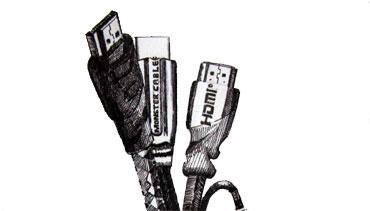Is Your HDMI-Connected Gear Ready for 3D?

Illustration by Raquel Chilson
Oh, boy. Where do I begin? Fasten your seatbelts; it's going to be a bumpy night. So…wires. You plug one end into A and the other end into B. Then electrons or some other things take care of the rest. Pretty simple, right? In the analog audio and video days, as long as the connectors were compatible, that usually worked.
Not so with digital. It's all about bandwidth, chip sets, firmware, and transport streams. Keeping up with the latest digital interconnections is a full-time job. HDMI is the preferred way to convey uncompressed A/V data between devices such as Blu-ray Disc players, receivers, and HDTVs. And HDMI is attractive because one cable can carry high-definition video and up to eight channels of audio, and HDMI-linked devices can be designed to control one another. HDMI is also "universal" because, for example, it's agnostic with respect to ATSC (North America) and DVB-T (Europe and elsewhere) digital television standards, conveying both equally well. HDMI is also backward compatible with DVI digital video signals, and it uses HDCP copy protection. Great stuff. And pretty simple again, right? Not really.
Like any technology, HDMI has evolved. Starting with version 1.0, which first showed up in products in 2003, it progressed through many different versions until reaching v1.4. That standard was released in May 2009 and offered some key improvements over v1.3. For example, it added an Ethernet connection channel to enable data sharing between connected devices as well as an audio-return channel. (Both features are optional; manufacturers aren't required to implement them in HDMI v1.4 products.) Most significant for our discussion here, it defined specifications for conveying 3D video. This 3D upgrade is a bit confusing. (Is your seatbelt secured?)
HDMI v1.4 provides support for the mandatory 3D 1080p/24 (movie) and 720p 60 (game) formats. "High Speed" HDMI cables currently used for v1.3 can carry 3D but not the optional v1.4 Ethernet channel. (You'll need a "High Speed with Ethernet" cable for that.) Now, there's where it starts to get dicey. Some HDMI v1.3 devices will support 3D video. For example, if you have a PS3, Sony plans to provide firmware upgrades that the company says will let you output 3D video from the console's existing port when watching 3D Blu-ray Discs. Knowing exactly what it is that your gear's HDMI connections can and cant' do can be confusing. For example, Sony claims that its newest "3D-ready" Blu-ray players can output 3D video, but because the ports don't support the full set of HDMI v1.4 features, the company isn't specifying which HDMI version is provided on the players.
- Log in or register to post comments



































































